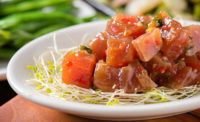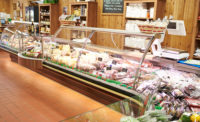The retail seafood sector is relatively calm, but below the surface is the potential for dynamic activity.
Although shopper interest in healthy eating is helping to fuel moderate category growth, retailers that offer seafood that meets the demand for excitement, affordability and convenience will be in position to accelerate activity. Fresh fish and shellfish saw sales of $9.5 billion in 2014, which accounted for 56.7 percent of sector revenues and was up from $8.7 billion in 2012, reports Mintel Group Ltd., a Chicago-based market research firm.
Frozen fish and shellfish sales reached $4.7 billion in 2014, generating 27.9 percent of overall revenues and an increase from $4.3 billion in 2012. Shelf-stable products such as canned tuna had revenues of $2.6 billion in 2014, accounting for 15.4 percent of sector sales, up from $2.5 billion in 2012.
Consumer affection for fresh foods is the key driver of greater fresh seafood sales, while improved taste and quality spur frozen revenue increases, Mintel notes.
To maximize activity, however, it is important for retailers to offer products and services that meet the varying aspirations of different shopper segments while alleviating their purchasing concerns, such as the ability to successfully create seafood-based meals and whether the items they are buying were raised in a sustainable environment.
A push for prepared foods
Many retailers are already moving to streamline the cooking process by merchandising more value-added selections, particularly freshly prepared seafood in unique recipes that shoppers can heat and eat.
“Preseasoned and marinated products, ethnic flavors and different prepared products, such as breaded varieties, will all help illustrate how fish and shellfish brands keep their products interesting,” Mintel reports. “Pairing new flavors with fresh products is ideal. Consumers perceive fresh fish and shellfish to be the highest quality, but innovative flavors will also help grow sales of frozen and shelf-stable products.”
Value-added seafood activity will likely increase as more retailers offer smaller portions of prepared foods that carry lower price tags, says Chuck Anderson, a Corpus Christi, Texas-based seafood consultant. Prepared fish and shellfish, which typically are displayed in the fresh seafood case, also will enable merchandisers to attract time-conscious and cooking-challenged shoppers who are reluctant to create seafood recipes from scratch.
Foodservice customers generate about 70 percent of total seafood sales because many consumers are not comfortable cooking the items at home, Anderson notes. Their reluctance stems from such factors as lack of seafood in their diets when growing up and negative experiences when previously trying to prepare seafood.
Popular value-added selections, which often are sold by the piece instead of by weight, include marinated and breaded tilapia and salmon, stuffed shrimp, salmon pinwheels, tortilla encrusted tilapia and seafood salads.
“More retailers are selling seafood in exact portions to bring the cost down,” Anderson says. “A 4-ounce portion of valued-added tilapia or salmon can sell for $5 and that is an attractive price for many shoppers. It often is difficult to find seafood that is less than 10 pounds, which many customers can’t afford.”
The price is not always right
Pricing, which often fluctuates because of supply issues, affects seafood merchandising and overall activity. Shrimp prices, for instance, are declining following record highs in 2014, resulting in more retail promotions, while salmon costs are starting to increase, Anderson says.
Such factors as greater seafood demand in the Asian market and lower numbers of salmon because of disease affect inventories and, subsequently, cost.
The increasing demand and higher prices of some wild-caught fish, meanwhile, is leading retailers to carry larger inventories of farm-raised seafood, Anderson says. Salmon, tilapia and shrimp are among the most prominent farm-raised selections. Other species, such as Asian sea bass, are increasing in popularity.
“Fifty percent of the world’s seafood is farm raised and it will continue to grow,” Anderson says. The evolving sourcing of seafood also will contribute to changes in the fresh-seafood case, Anderson says, noting there will be fewer selections of expensive wild-caught fish and more SKUs of popular species, such as five to eight types of salmon.
“Fresh cod often sells for $12 a pound, and haddock and ocean perch also are priced high,” Anderson says. “Fewer retailers are carrying such items or are only merchandising the selections for limited periods because of concerns that the seafood will go unsold. If consumers don’t purchase the fish, it results in shrink.”
Consumer buying behavior, meanwhile, often varies by demographics. The most frequent seafood purchasers are affluent shoppers, with one-third of households accounting for 81 percent of all seafood sales, reports the Nielsen Perishables Group, a Chicago-based fresh foods research and consulting firm.
Such shoppers are more willing to pay high prices for seafood. Mintel found that 30 percent of fish or shellfish buyers bought premium quality items in the previous three months. Premium seafood includes items with such attributes as being imported, organic and free from antibiotics and hormones.
Sixty-nine percent of consumers (and 73 percent of those 35 and older), meanwhile, say they eat seafood as an entrée, or part of their entrée, at least once within 90 days, reports Technomic Inc., a Chicago-based food and foodservice research and consulting firm.
In addition, 47 percent of those who eat seafood at least once a month say they choose it over other proteins because it’s healthier, and 68 percent do so because they “just like it,” Technomic notes.
Twenty-seven percent of the consumers, and 39 percent of persons under age 35, are interested in unique seafood varieties, Technomic adds.
Millennials lead a movement
Millennials, the consumer segment typically categorized as being in their late teens to mid-30s, are among the most active preparers of seafood.
Many younger persons who can’t afford to eat at restaurants are experimenting at home with recipes, including fusion cuisines and “hip and trendy” seafood dishes that television food programs spotlight, Anderson says.
Millennials also often have a strong interest in wellness-oriented and premium items, as well as newer alternatives, notes Matt Lally, Nielsen Perishables Group manager of analytics.
Overall, shoppers are equally inclined to buy wild-caught and farm-raised fish and shellfish. While many consumers likely perceive wild caught as healthier and higher quality, farm raised is typically attractive to people concerned about sustainability, Mintel says.
Offering optimal packaging, meanwhile, also helps strengthen seafood sales. Twenty-nine percent of consumers who eat fish or shellfish at least once a month, for instance, are significantly likely to want to see more resealable packages, which helps reduce fears of spoilage, Mintel reports.
In addition, 25 percent of shoppers want to see more single-serve packs that cater to the greater number of single-person households; and 23 percent of consumers seek family-size packs for larger households.
Also appealing are convenience-oriented attributes, including on-package recipes, and health-related elements, such as items with no additives or preservatives, and low, no or reduced amounts of sodium, Mintel reports.
Retailers can effectively spotlight health claims through in-store signage and associates’ communication with customers, Lally says.
That includes articulating the nutrients in seafood, such as Omega-3 fatty acids, as well as detailing the benefits of specific nutrients, including those which help to lower blood pressure or reduce the risk of heart disease.
Other ways to enhance seafood’s appeal is by displaying products in ways that convey freshness, and cross-merchandising seafood with items from other departments to illustrate potential meals, such as pairing bottles of wine or value-added vegetables with fish, Lally says.
The power of data
On-pack graphics and recipe cards also enable retailers to disseminate product information and illustrate easy ways to prepare meals, adds Mary Chapman, Technomic senior director of innovation.
“Consumers don’t always know how to prepare seafood beyond a simple grilling or sauté method,” she says. “There also is sometimes uncertainty over what the terms ‘wild caught’ and ‘farm raised’ mean, the aspects of such items and where products were caught. Consumers want to know more and more.”
Many shoppers, Chapman says, are more inclined to purchase seafood from restaurants because servers can describe what specific recipes look and taste like and where the fish was sourced. Retailers also can summarize such information.
“It is easy and it does not require a lot of research to tell the story of the product,” Chapman says.
Anderson notes that hiring and educating the appropriate seafood associates who can talk knowledgeably about products to consumers is crucial for generating and retaining seafood customers. The subsequent activity can help reduce shrink, a major challenge for merchandisers.
“Many retailers are losing money at the seafood service counter and have to decide if they will only do self-service or still offer full service to better compete,” Anderson says.
While health benefits and enticing flavors make seafood an attractive protein, fluctuating inventories, shopper uncertainty on how to prepare items and pricing issues have an impact on sales. But by offering value-added options that streamline preparation; pricing items by the piece, which many consumers perceive as being more affordable; and educating shoppers on the sourcing, wellness attributes and how to cook attractive seafood recipes, retailers are in position to make a greater category splash. NP
Stepping out for stylish seafood
The majority of consumers eat seafood at foodservice locations, but many operators are not taking the activity for granted.
Menus keep evolving as chefs respond to customer demands for new, exciting and flavorful offerings by invigorating the most popular species, including salmon, tilapia, shrimp, lobster and crab.
Among the trendy offerings are shrimp and grits, lobster rolls, fish and chips containing premium fish instead of traditional cod, upscale tacos featuring fried battered shrimp, and flat bread and pizza with grilled shrimp, says Jana Mann, senior director, Menu Trends, for Datassential, a Chicago-based food research firm.
“Progressive chefs are looking to interest foodies by making items more upscale,” she says. “They are being more creative with their offerings.”
Newer selections, meanwhile, are offered at a wide variety of locations, including fine dining, casual, fast casual and independent restaurants, and include entrées, smaller plate items, appetizers and snacks.
Recent rollouts from chain restaurants include Butterfly Shrimp from Atlanta-based Popeyes Louisiana Kitchen, a premium shrimp marinated in Louisiana seasonings and breaded in a crispy crust.
Popeyes also offers Cajun Fish, a tender, premium whole-fillet whitefish seasoned in a blend of Louisiana spices with crispy Southern-style crumb breading.
Launches from Orlando, Fla.-based Red Lobster include Caribbean-Grilled Salmon & Shrimp, grilled salmon drizzled with Captain Morgan BBQ Sauce and topped with shrimp in a mango beurre blanc.
Homestead, Pa.-based Eat n’ Park, meanwhile, offers Baked Lemon Sole, a flaky sole filet lightly crusted with Parmesan breadcrumbs and drizzled with butter and fresh-squeezed lemon.
A change in the lineups
While the number of seafood items on menus remains stable, specific species are becoming more, and less, prominent.
Salmon, tilapia and fish and chips remain prevalent, but swordfish, trout, halibut and snapper dishes are declining, says Mary Chapman, senior director of innovation at Technomic Inc., a Chicago-based food and foodservice research and consulting firm. Escolar, abalone and herring, meanwhile, had the largest increases on restaurant menus over the last year, she adds.
Such changes often result from the availability and popularity of the different types of seafood.
More restaurants also are featuring premium ingredients and innovative flavors and sauces to differentiate their offerings from competitors’, Mann says.
“About 28 percent of consumers consider themselves foodies and they are becoming more progressive,” she says. “Their expectations are higher than they used to be.”
In addition to more innovative selections is the growing use of additional parts of the fish in recipes to reduce waste.
Unconventional parts gaining prominence include cheeks, which have a delicate, sweet flavor and can be served raw; the collar, which is a rich, fattier part of the fish that works well grilled or in stew and curries; liver, which can be steamed and served with a light dipping sauce; and stronger flavored fish skins, which can be fried and eaten as a bar snack, Datassential reports.
“It is better for the environment to use everything from the fin to the tail,” Mann says. “There is a movement to discard seafood when there is less weight.”
— Rich Mitchell








Report Abusive Comment